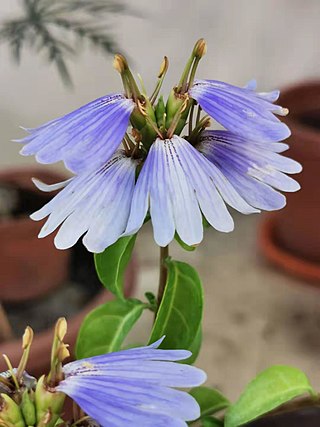
Acanthaceae is a family of dicotyledonous flowering plants containing almost 250 genera and about 2500 species. Most are tropical herbs, shrubs, or twining vines; some are epiphytes. Only a few species are distributed in temperate regions. The four main centres of distribution are Indonesia and Malaysia, Africa, Brazil, and Central America. Representatives of the family can be found in nearly every habitat, including dense or open forests, scrublands, wet fields and valleys, sea coast and marine areas, swamps, and mangrove forests.

Justicia is a genus of flowering plants in the family Acanthaceae. It is the largest genus within the family, with over 900 accepted species. They are native to tropical to warm temperate regions of the Americas, India, and Africa. The genus serves as host to many butterfly species, such as Anartia fatima. Common names include water-willow and shrimp plant, the latter from the inflorescences, which resemble a shrimp in some species. The generic name honours Scottish horticulturist James Justice (1698–1763). They are closely related to Pachystachys.

Acanthus is a genus of about 30 species of flowering plants in the family Acanthaceae, native to tropical and warm temperate regions, with the highest species diversity in the Mediterranean Basin and Asia. This flowering plant is nectar-producing and depends on butterflies, such as Anartia fatima, and other nectar-feeding organisms to distribute its pollen. Common names include Acanthus and bear's breeches. The generic name derives from the Greek term ἄκανθος (akanthos) for Acanthus mollis, a plant that was commonly imitated in Corinthian capitals.

Barleria is a genus of plants in the family Acanthaceae. It includes 303 species native to the tropics and subtropics, including the Americas from Mexico to northern South America, sub-Saharan Africa, Egypt and the Arabian Peninsula, the Indian subcontinent, Indochina, southern China and Taiwan, parts of Malesia, and New Guinea.

Dicliptera is a genus of flowering plants in the bear's breeches family, Acanthaceae. It includes 223 species native to the tropics and subtropics worldwide. Well-known synonyms include Peristrophe and Dactylostegium.

Hygrophila, commonly known as swampweeds, is a genus of flowering plants in the acanthus family, Acanthaceae. There are about 80 to 100 species, of which many are aquatic plants. The genus is distributed across the tropical and subtropical world. It is one of only two genera in its family that contains aquatic plants, the other being Justicia. The genus is treated in the tribe Hygrophileae, which is noted as being in need of revision at the genus level, meaning the current taxonomic boundaries of Hygrophila are likely to change in the future.

Hypoestes is a flowering plant genus of about 150 species. They are widely distributed throughout the tropical and subtropical lands around the Indian Ocean, and some adjacent regions.

Andrographis is a genus of flowering plants in the family Acanthaceae. They may be generally known as the false waterwillows, and several are called periyanagai.

The genus Asystasia belongs to the family Acanthaceae and comprises 59 species found in the tropics of Africa, Asia, Australia, and New Guinea. It includes the weedy species Asystasia gangetica.

Anisotes is a genus of Afrotropical plants in the family Acanthaceae. The genus is morphologically similar to Metarungia, from which it differs mainly in the dehiscence of the fruit capsule, and the nature of the placenta. Placentas remain attached to the inner surface of fruit capsules in Anisotes.

Blepharis is a genus of plant in family Acanthaceae. It contains around 128 species found in seasonally dry to arid habitats from Africa through Arabia to Southeast Asia. In section Acanthodium, there are 13–15 species that use the C4 carbon fixation pathway. Phylogenetic analysis suggests that this pathway evolved up to three times independently in the genus over the last five million years.

Brachystephanus is a genus of flowering plants in the family Acanthaceae. It includes 21 species native to tropical Africa and Madagascar.

Isoglossa is a genus of flowering plants in the family Acanthaceae. It includes 78 species native to tropical Africa, Yemen, the eastern Himalayas, southern China, Indochina, Peninsular Malaysia, Java, Sulawesi, the Lesser Sunda Islands, and New South Wales.

Pseuderanthemum is a genus of plants in family Acanthaceae with a pantropical distribution.

Sclerochiton is a genus of flowering plants in the family Acanthaceae. It includes 18 species native to tropical and southern Africa.

Crossandra is a genus of plants in the family Acanthaceae, comprising 54 species that occur in Africa, Madagascar, Arabia and the Indian subcontinent. Some species, especially Crossandra infundibuliformis, are cultivated for their brightly colored flowers.

Dyschoriste is a genus of flowering plants in the family Acanthaceae. It includes 98 species native to the tropics and subtropics of the Americas, sub-Saharan Africa, and southern Asia. Members of the genus are commonly known as snakeherb.

















